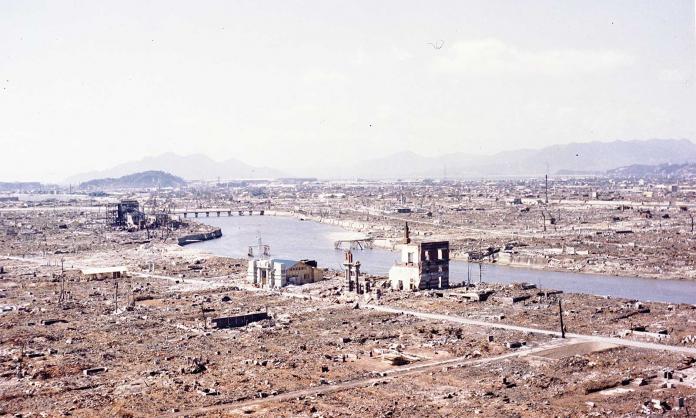“People exposed within half a mile of the Little Boy fireball were seared to bundles of smoking black char in a fraction of a second as their internal organs boiled away. The small black bundles now stuck to the streets and bridges and sidewalks of Hiroshima numbered in the thousands. At the same instant birds ignited in midair. Mosquitoes and flies, squirrels, family pets crackled and were gone.”
—Richard Rhodes, The making of the atomic bomb
“Little Boy” was the ludicrously innocuous name of the uranium bomb dropped on the Japanese city of Hiroshima on 6 August 1945, destroying 70 percent of its buildings. This single bomb had unprecedented destructive power, with an explosive yield equal to 15,000 tonnes of TNT. Three days later, the “Fat Man”, an even more powerful and deadly plutonium bomb, razed the city of Nagasaki, levelling 6.7 square kilometres.
To this day, it remains uncertain how many people perished when US planes unleashed these deadly weapons of mass destruction, causing ground temperatures to reach 4,000°C and radioactive rain to pour down. According to the Bulletin of the Atomic Scientists, as many as 210,000 (140,000 at Hiroshima and 70,000 at Nagasaki) died up to the end of 1945. The vast majority were non-combatant civilians—women, children and older people.
Those deaths were only the start: the effects lasted for decades and are still being felt. Those who survived the initial firestorms endured terrible side effects from radiation exposure. Pregnant women experienced high rates of miscarriage and still births, while children exposed in utero were more likely to have birth defects, intellectual disabilities or impaired growth, as well as an increased risk of developing cancer. In the decade following the bombings, there was a marked increase in incidence of leukaemia, as well as thyroid, breast, lung and other cancers.
The bombings were not only war crimes; they were crimes against humanity. But it’s always the victors who control the narrative, and in this case the enduring myth is that the use of nuclear weapons was necessary to bring an end to the war. It wasn’t.
The decision to drop atom bombs was a political, not a military, decision. It was opposed by every one of the Joint Chiefs of Staff and most of the US’s top military officials. They all believed that Japan—its air force and navy shattered, its harbours mined and blockaded and 40 percent of its major cities destroyed—was ready to surrender. The 1946 United States Strategic Bombing Survey in Japan concurred:
“Based on a detailed investigation of all the facts ... it is [our] opinion that ... Japan would have surrendered even if the atomic bombs had not been dropped, even if Russia had not entered the war, and even if no invasion had been planned or contemplated.”
At school, we’re taught that World War Two was a “war for democracy”. Nothing could be further from the truth. Like World War One, it was a war for empire: the inevitable outcome of capitalist competition, with the most powerful states striving to carve up the world between them. Each was determined to increase their economic and political power at the expense of the others, to create spheres of influence in which their respective capitalist classes could maximise their profits.
World War Two is best understood, as historian Richard Overy put it, as one between “incumbent” and “insurgent” imperialist powers—primarily Britain, France and the US (the Allies) on one hand, and Germany, Japan and Italy (the Axis) on the other. The Allied powers held fifteen times more colonial acreage than the Axis states. As the head of Britain’s navy candidly observed in 1934, “We have got most of the world already, or the best parts of it. We ... want to keep what we have got and prevent others from taking it away from us”. The Axis powers sought to redivide the world and grab a bigger share for themselves.
The USSR was also an emerging power; Stalin had consolidated his counter-revolutionary rule in the late 1920s and embarked on a program of rapid forced industrialisation to catch up with the West. He was determined to restore and expand the Russian empire, and industrialisation was key to being able to compete militarily with the likes of the US and Britain.
Initially, Stalin made a deal with Hitler, but joined the Allied side when Germany attacked Russia in June 1941. The Japanese bombing of Pearl Harbour in December 1941 provided the pretext for the US to join the war. A State Department memorandum a year earlier had warned that the US’s “diplomatic and strategic position would be considerably weakened ... by our loss of Chinese, Indian and South Seas markets (and by our loss of much of the Japanese market for our goods ...) as well as by insurmountable restrictions upon our access to the rubber, tin, jute, and other vital materials of the Asian and Oceanic regions”.
The entry into the war of the US and the Soviet Union shifted the military balance decisively. However, once it was clear that the Allies would win the war in Europe, the rivalry between them came to the fore. There was a flurry of deal making as their leaders jockeyed for maximum advantage in the postwar world. There was nothing democratic about this: the people of Eastern Europe, for example, got no say about being brought under the domination of the USSR.
The Manhattan Project—set up in 1942 to produce nuclear weapons—was well underway when Roosevelt, Stalin and Churchill met at Yalta, Crimea, in February 1945, but the bomb had not yet been tested. The USSR was not at war with Japan at this point, and the Americans believed Russian ground troops would be needed to win the war in Asia. So, in return for Stalin’s pledge to declare war on Japan once victory in Europe was concluded, the US and Britain agreed to territorial concessions.
By the time of the Potsdam conference in July, the situation had altered. The war in Europe had ended with Germany’s surrender in June, and the bomb had been successfully tested. This changed US strategic thinking. Secretary of State James Byrnes advised new US President Truman that “the bomb might well put us in a position to dictate our terms at the end of the war”.
A demonstration of the military power of the US would provide leverage in negotiating the postwar world order to its advantage, intimidating the Russians and keeping them out of Japan and China. The certainty of hundreds of thousands of civilian deaths was no deterrent. On the contrary, as one historian wrote: “[Hiroshima and Nagasaki] had been chosen not despite but because they had a high density of civilian housing ... the attacks were to be a show, a display, a demonstration”.
On receiving the news of the Hiroshima bombing, on his way home from Potsdam, Truman declared it to be “the greatest thing in history”.
The use of atomic weapons was not the first atrocity visited on Japan. In 1944, Britain and the US had begun saturation bombings of cities in Germany and Japan respectively, in a deliberate strategy designed to “undermine civilian morale”—a euphemism for the mass murder of civilians that would become standard US policy in Korea, Vietnam and Iraq.
On a single night in March 1945, US planes dropped on Tokyo masses of incendiary bombs containing an early version of napalm. The fires spread rapidly through the flimsy dwellings of the poor, and the atmosphere became superheated to almost 1,000°C. An estimated 125,000 people died of oxygen deficiency, carbon monoxide poisoning, radiant heat, direct flames or flying debris or were trampled to death; those who jumped into the river for protection were boiled alive.
In August 1946, the New Yorker published a lengthy article by war correspondent John Hersey, graphically describing the results of the Hiroshima bomb, including the horrific effects of radiation poisoning. Many were reading about this for the first time, and the article had a huge impact. As a defender of the bombing observed, it “did not moralize or sensationalize”, but “humanize[d] what the Air Force publicists had always taken pains to keep abstract: civilian death”.
James Conant, a key figure in the Manhattan Project, feared that the truth about Hiroshima and Nagasaki would weaken the resolve of future Cold War leaders, and that he and others who worked on the bomb would be seen as war criminals. He pressured Secretary of War Henry Stimson to write a response justifying the bombing as “the least abhorrent choice”. Stimson was reluctant, confiding to a friend his fear that “the full enumeration of the steps in the tragedy will excite horror”. The friend, a former Supreme Court justice, replied that it was necessary to combat “sloppy sentimentality”, and silence “self-righteous critics”.
Following the publication of Stimson’s article, most mainstream commentary fell into line, and the lie has persisted despite the evidence.
In wars, atrocities are committed by all sides. The war crimes of the Nazis and the Japanese army are well documented and rightly condemned, but the idea that “our side” is untainted is refuted by numerous examples. Think of the war on Iraq—justified with false claims about weapons of mass destruction. The city of Fallujah was heavily bombarded by US Marines in 2004, their weapons made even more lethal by the addition of white phosphorus, the use of which in inhabited areas is supposedly banned by the UN. Since then, there has been a dramatic increase in infant mortality, serious birth defects, leukaemia and other cancers.
A study titled “Cancer, Infant Mortality and Birth Sex-Ratio in Fallujah, Iraq 2005–2009”, reported that the types of cancer there are “similar to [those suffered by] Hiroshima survivors who were exposed to ionising radiation from the bomb and uranium in the fallout”; and indeed, that the toxic legacy of the US assault on Fallujah is even “worse than Hiroshima”—for example a 38-fold increase in leukaemia as compared to a 17-fold increase in Hiroshima.
Today, the weapons at the disposal of our rulers are more destructive than ever. The Bulletin of the Atomic Scientists’ Doomsday Clock now stands at 90 seconds to midnight, the closest to global catastrophe it has ever been, because of Russia’s threats to use atomic weapons against Ukraine. But the growing danger of a war between the US and China also looms large. Either could spiral out of control. Capitalist competition in the form of imperialism makes wars inevitable. The only way to stop them—and atrocities like Hiroshima and Nagasaki—is to get rid of this barbaric system.











